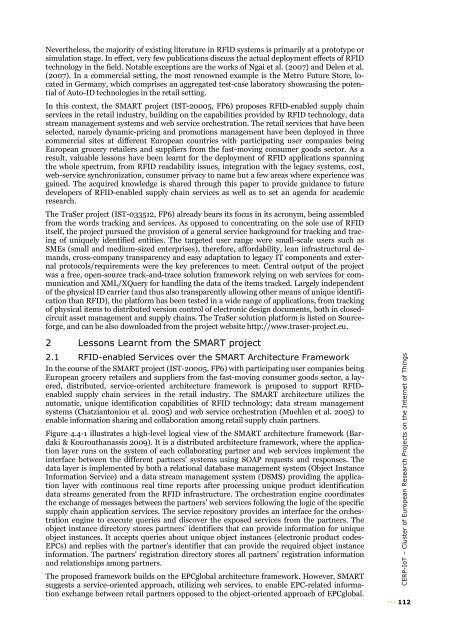Vision and Challenges for Realising the Internet of Things
Vision and Challenges for Realising the Internet of Things
Vision and Challenges for Realising the Internet of Things
You also want an ePaper? Increase the reach of your titles
YUMPU automatically turns print PDFs into web optimized ePapers that Google loves.
Never<strong>the</strong>less, <strong>the</strong> majority <strong>of</strong> existing literature in RFID systems is primarily at a prototype or<br />
simulation stage. In effect, very few publications discuss <strong>the</strong> actual deployment effects <strong>of</strong> RFID<br />
technology in <strong>the</strong> field. Notable exceptions are <strong>the</strong> works <strong>of</strong> Ngai et al. (2007) <strong>and</strong> Delen et al.<br />
(2007). In a commercial setting, <strong>the</strong> most renowned example is <strong>the</strong> Metro Future Store, located<br />
in Germany, which comprises an aggregated test-case laboratory showcasing <strong>the</strong> potential<br />
<strong>of</strong> Auto-ID technologies in <strong>the</strong> retail setting.<br />
In this context, <strong>the</strong> SMART project (IST-20005, FP6) proposes RFID-enabled supply chain<br />
services in <strong>the</strong> retail industry, building on <strong>the</strong> capabilities provided by RFID technology, data<br />
stream management systems <strong>and</strong> web service orchestration. The retail services that have been<br />
selected, namely dynamic-pricing <strong>and</strong> promotions management have been deployed in three<br />
commercial sites at different European countries with participating user companies being<br />
European grocery retailers <strong>and</strong> suppliers from <strong>the</strong> fast-moving consumer goods sector. As a<br />
result, valuable lessons have been learnt <strong>for</strong> <strong>the</strong> deployment <strong>of</strong> RFID applications spanning<br />
<strong>the</strong> whole spectrum, from RFID readability issues, integration with <strong>the</strong> legacy systems, cost,<br />
web-service synchronization, consumer privacy to name but a few areas where experience was<br />
gained. The acquired knowledge is shared through this paper to provide guidance to future<br />
developers <strong>of</strong> RFID-enabled supply chain services as well as to set an agenda <strong>for</strong> academic<br />
research.<br />
The TraSer project (IST-033512, FP6) already bears its focus in its acronym, being assembled<br />
from <strong>the</strong> words tracking <strong>and</strong> services. As opposed to concentrating on <strong>the</strong> sole use <strong>of</strong> RFID<br />
itself, <strong>the</strong> project pursued <strong>the</strong> provision <strong>of</strong> a general service background <strong>for</strong> tracking <strong>and</strong> tracing<br />
<strong>of</strong> uniquely identified entities. The targeted user range were small-scale users such as<br />
SMEs (small <strong>and</strong> medium-sized enterprises), <strong>the</strong>re<strong>for</strong>e, af<strong>for</strong>dability, lean infrastructural dem<strong>and</strong>s,<br />
cross-company transparency <strong>and</strong> easy adaptation to legacy IT components <strong>and</strong> external<br />
protocols/requirements were <strong>the</strong> key preferences to meet. Central output <strong>of</strong> <strong>the</strong> project<br />
was a free, open-source track-<strong>and</strong>-trace solution framework relying on web services <strong>for</strong> communication<br />
<strong>and</strong> XML/XQuery <strong>for</strong> h<strong>and</strong>ling <strong>the</strong> data <strong>of</strong> <strong>the</strong> items tracked. Largely independent<br />
<strong>of</strong> <strong>the</strong> physical ID carrier (<strong>and</strong> thus also transparently allowing o<strong>the</strong>r means <strong>of</strong> unique identification<br />
than RFID), <strong>the</strong> plat<strong>for</strong>m has been tested in a wide range <strong>of</strong> applications, from tracking<br />
<strong>of</strong> physical items to distributed version control <strong>of</strong> electronic design documents, both in closedcircuit<br />
asset management <strong>and</strong> supply chains. The TraSer solution plat<strong>for</strong>m is listed on Source<strong>for</strong>ge,<br />
<strong>and</strong> can be also downloaded from <strong>the</strong> project website http://www.traser-project.eu.<br />
2 Lessons Learnt from <strong>the</strong> SMART project<br />
2.1 RFID-enabled Services over <strong>the</strong> SMART Architecture Framework<br />
In <strong>the</strong> course <strong>of</strong> <strong>the</strong> SMART project (IST-20005, FP6) with participating user companies being<br />
European grocery retailers <strong>and</strong> suppliers from <strong>the</strong> fast-moving consumer goods sector, a layered,<br />
distributed, service-oriented architecture framework is proposed to support RFIDenabled<br />
supply chain services in <strong>the</strong> retail industry. The SMART architecture utilizes <strong>the</strong><br />
automatic, unique identification capabilities <strong>of</strong> RFID technology; data stream management<br />
systems (Chatziantoniou et al. 2005) <strong>and</strong> web service orchestration (Muehlen et al. 2005) to<br />
enable in<strong>for</strong>mation sharing <strong>and</strong> collaboration among retail supply chain partners.<br />
Figure 4.4-1 illustrates a high-level logical view <strong>of</strong> <strong>the</strong> SMART architecture framework (Bardaki<br />
& Kourouthanassis 2009). It is a distributed architecture framework, where <strong>the</strong> application<br />
layer runs on <strong>the</strong> system <strong>of</strong> each collaborating partner <strong>and</strong> web services implement <strong>the</strong><br />
interface between <strong>the</strong> different partners’ systems using SOAP requests <strong>and</strong> responses. The<br />
data layer is implemented by both a relational database management system (Object Instance<br />
In<strong>for</strong>mation Service) <strong>and</strong> a data stream management system (DSMS) providing <strong>the</strong> application<br />
layer with continuous real time reports after processing unique product identification<br />
data streams generated from <strong>the</strong> RFID infrastructure. The orchestration engine coordinates<br />
<strong>the</strong> exchange <strong>of</strong> messages between <strong>the</strong> partners’ web services following <strong>the</strong> logic <strong>of</strong> <strong>the</strong> specific<br />
supply chain application services. The service repository provides an interface <strong>for</strong> <strong>the</strong> orchestration<br />
engine to execute queries <strong>and</strong> discover <strong>the</strong> exposed services from <strong>the</strong> partners. The<br />
object instance directory stores partners’ identifiers that can provide in<strong>for</strong>mation <strong>for</strong> unique<br />
object instances. It accepts queries about unique object instances (electronic product codes-<br />
EPCs) <strong>and</strong> replies with <strong>the</strong> partner’s identifier that can provide <strong>the</strong> required object instance<br />
in<strong>for</strong>mation. The partners' registration directory stores all partners’ registration in<strong>for</strong>mation<br />
<strong>and</strong> relationships among partners.<br />
The proposed framework builds on <strong>the</strong> EPCglobal architecture framework. However, SMART<br />
suggests a service-oriented approach, utilizing web services, to enable EPC-related in<strong>for</strong>mation<br />
exchange between retail partners opposed to <strong>the</strong> object-oriented approach <strong>of</strong> EPCglobal.<br />
CERP-IoT – Cluster <strong>of</strong> European Research Projects on <strong>the</strong> <strong>Internet</strong> <strong>of</strong> <strong>Things</strong><br />
112
















